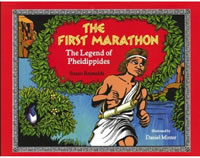
Lance
Bryant | Completing
26.2 in Your Class
Lance G. Bryant,
Ph.D.
It seems that with the running
boom over the past decade, the
rise in the number of adults accomplishing
the 26.2 mile marathon distance
has steadily been increasing.
At one time, a finisher could
have claimed to be in the top
1% of the population. Today however,
with the high number of individuals
crossing the finish line, more
and more moms and dads are making
it a "family affair,"
with some even soliciting the
advice of their local expert,
the physical education teacher.
Students from elementary to secondary
levels are inquiring about how
to get involved. Depending on
the age of your students, or the
look you might receive from your
administrators, it may not be
advisable to jump into an 18-week
unit that involves marathon training.
|
However, providing
students with the opportunity to attain
the 26.2 mile distance is possible!
Many larger marathons around the country
are introducing an additional event,
often called a "kids marathon," where
children/students from kindergarten
through sixth grade participate in an
incremental running program (over 18
weeks) that culminates with each child/student
running and or walking the final mile
on the actual marathon course. Each
participant receives a finisher's medal
as they cross the finish line. Students
can run in your physical education class,
or with a parent or a community volunteer
coach, and keep a log
sheet to track his or her progress
over the 18-week period.
Mileage is based
on an adult's supervision and/or the
honor system. The 18-week plan provides
an ideal platform for children/students
to build cardiovascular endurance, enhance
their self-esteem, and have fun! A unit
such as this can enhance your daily
lessons by teaching the importance of
health and fitness as a regular part
of life. It's not about speed or competition
amongst your students, but about teaching
the importance of setting long term
goals and accomplishing them.
 Would
you have to override your already planned
out activities to accomplish this? Would
you have to override your already planned
out activities to accomplish this?
Absolutely not! To attain weekly mileage
you might wish to incorporate a running
or walking activity at the beginning
or end of your class, 1 or 2 times a
week. Help them keep their log sheets
or teach them how to record distance.
Make an interdisciplinary lesson by
incorporating calculation of distance
(math), or introduce the lesson by reading
your students a book (reading skills/literature)
about running. An excellent choice,
depending on your student's age range,
is "The
First Marathon: The Legend of Pheidippides"
by Susan Reynolds (2006, ISBN 0807508675).
What if I teach in an area
that doesn't host a "big"
marathon or the nearest one is hours
away?
Transportation of students is always
a concern. If you live in an area where
the nearest marathon is hours away,
or if the marathon you're considering
doesn't have a "kids marathon,"
then create a "Race Day" with
a festive atmosphere, where the entire
school gets a chance to watch. Have
balloons, medals, a timing clock, refreshments,
etc. Or, have your 18-week plan culminate
with any "field day" activities
or "open houses." It can be
done thousands of ways!
I have other teachers interested
in getting involved – as a participant!
Great! Enlist them in your program or
create a program just for them. Help
other teachers set long term goals and
accomplish them. You might like to tweak
this idea in a way that is geared toward
creating a program for teachers in your
school. Ideas include training together
before or after school or on the weekends,
assisting each other in maintaining
better eating habits, and keeping a
log of your weekly mileage. If 26.2
is not your idea of fun, pick a shorter
distance (5K/10K/Half-marathon).
Does everyone really have a
chance to participate?
I implemented an extremely successful
program similar to this for a class
of students with disabilities in a local
middle school. Relying heavily on their
input and ideas, we came up with a plan
together in which the main goal was
to create a "daily physical activity"
log. Students could choose to complete
a range of activities that each had
distance values associated with them.
As they completed their chosen activities,
similar to the 18-week plan above, they
got closer to the 26.2 mile mark. On
"Race Day," which coincided
with a health fair at the school, all
of the students ran/walked a distance
to the "finish line" where
they received a finisher's medal and
all the accolades that go along with
completing the 26.2 mile feat.
There are endless possibilities to
this idea – don't be afraid to
let your mind go for a run!
(pelinks4u
home) |



